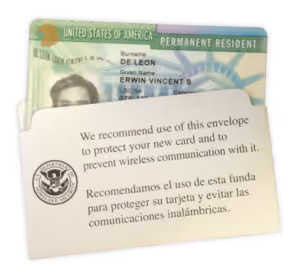How to Become a United States Citizen
Last Updated: January 15, 2020.
Thinking about applying for United States citizenship?
This guide will teach you everything you need to know about how to become a United States citizen.
There are 3 main steps to applying for U.S. citizenship and multiple steps in between. Starting with applying for a visa, getting a green card, then finally applying for citizenship. Keep in mind that the total time to immigrate to the U.S. and become a U.S. citizen is between six and seven years.
Let's get started.
Step 1: Apply For a Visa
You're living in Country X when you realize it's time to make your move. You want to immigrate to America.
The first thing you need to do is obtain a visa from the Department of Homeland Security's U.S. Citizenship and Immigration Services (USCIS). A visa is a pass that allows you to enter the United States and stay here for a specific length of time. There are two types of visa.
- Nonimmigrant visas: For those who simply want to travel to the U.S.
- Immigrant visas: For those who wish to move to the U.S. permanently
You want to apply for an immigrant visa (a visa is not the same as a green card; more on green cards in a bit). With a few exceptions, to be eligible to apply for an immigrant visa, you must be sponsored by either
- A relative who is a U.S. citizen or a lawful permanent resident
- A prospective employer
If you're immigrating based on family: Your sponsor begins the process by filing form I-130 Petition for Alien Relative with USCIS. Filing this form costs $535 and can be paid with a check or money order.
If you're immigrating based on employment: Your sponsoring employer begins the process by filing form I-140 Petition for Alien Worker with USCIS. In some highly skilled employment categories, you can file the I-140 petition yourself.
Exceptions to family-based or employment-based visa categories: The majority of immigrants who are granted visas do so in the family-based or employment-based visa categories. But as mentioned above, there are exceptions. These include:
- Petition for a foreign fiancé(e) to get married in the U.S.
- Petition for a child adopted abroad to be adopted in the U.S.
- Petitions covered by special types of workers or special circumstances established by the U.S. government
- Diversity visas — granted in limited number to people from countries with historically low U.S. immigration rates.
- Entrepreneur visas — granted to entrepreneurs (and their spouses and unmarried children under 21) who invest in a U.S. business enterprise, thereby creating or preserving 10 permanent full-time jobs in the U.S.
Once your sponsor's petition is approved by USCIS, you will have to:
- Collect and submit the appropriate paperwork to the National Visa Center
- Entrepreneur visas — granted to entrepreneurs (and their spouses and unmarried children under 21) who invest in a U.S. business enterprise, thereby creating or preserving 10 permanent full-time jobs in the U.S.
- Pay fees (between $205 and $345, depending on your status)
- Complete an interview with a consular officer
If and when you're approved — congrats! You are now able to enter and stay in the United States. Next stop: green card.
Step 2: Apply For a Green Card

A visa allows you to stay in the U.S. for a set period of time, and when that time is up, you have to go. With a green card, however, you become a lawful permanent resident of the U.S., and you can live and work here indefinitely. Applying for a green card is the next step in the process of becoming a U.S. citizen.
Who can apply? People are granted green cards under similar categories that they are visas — i.e., based on having either family or employment in the U.S. Again, special categories exist, including status as a refugee or asylee (someone who has been granted asylum in the U.S.). It's important to note that except for immediate family of U.S. citizens, a limited number of green cards are issued each year, and there are priorities and preferences for certain categories of immigrants.
Getting a green card based on family: Priority is given to the spouse, parents and unmarried children under age 21 of a U.S. citizen. These people do not have to wait for a visa to become available before they can get a green card.
Read: The Ultimate Guide on Getting a Green Card
Getting a green card based on employment: There is also an order of preference for people who wish to immigrate to the U.S. for employment. First preference goes to "priority workers," including exceptional professors and researchers and others with extraordinary abilities. To see the complete order of preference for workers, visit the USCIS website.
Getting a green card based on humanitarian reasons: You may be able to get a green card through your status as a refugee or asylee.
- If you're a refugee, the law requires you to apply for your green card within a year of entering the U.S.
- If you have been granted asylum in the U.S., the law requires you to apply for your green card within a year of asylum status being granted
Other special categories: A variety of special categories exist that enable you to get a green card, including.
- You want to invest $1 million or more in a U.S. business
- You're a religious worker or member of the clergy coming here to work in certain circumstances
- You're a former overseas U.S. government worker
Once you file your green card application and all supporting documents and fees, USCIS will schedule an interview with you. For green card applications and help filling out the forms, visit SimpleCitizen.com.
The next step: Conditional permanent resident status vs. permanent resident status. Once you're approved (congrats!), you become a conditional permanent resident, and you'll be issued a conditional green card. It's good for two years. At some point during the 90 days before the card expires, you must file Form I-751, Petition to Remove Conditions on Residence. You cannot renew a two-year green card — you must apply to have the conditions removed.
Once the conditions are removed, you are granted a permanent resident green card. It's valid for 10 years. You may renew it by filing Form I-90, Application to Replace Permanent Resident Card.
So once you have your permanent resident green card, now you can apply to become a U.S. citizen, right?
Not quite.
Ways to Apply for a Green Card
Fill Out On a Computer
Download and view in a PDF viewer.
Download PDF
SimpleCitizen's Application Builder
Complete a Green Card application with SimpleCitizen.
Get Started*Includes Attorney Review
Print & Fill Out Paper Form
Print the PDF and fill by hand with black pen.
Print PDF
Hire a Legal Professional
Find a legal professional to complete the form.
Visit AILA.com
Step 3: Apply for American Citizenship (after 3 or 5 years)
You must be a permanent resident of the U.S. (aka having your green card) for five years before you become eligible for naturalization (aka becoming a U.S. citizen). USCIS does permit you to submit your naturalization application up to 90 days before your five-year anniversary.
Are there any exceptions to the five-year rule? Yes, there are:
- Permanent residents who are married to U.S. citizens only have to wait three years to apply for citizenship
- Battered spouses of a U.S. citizen also only have to wait three years
- Spouses of U.S. citizens in certain overseas jobs, refugees and asylees all have special circumstances that may permit them to apply for citizenship earlier than five years
Next step: You've had your green card for three or five years (or however long USCIS mandates, based on your status), and you'd like to apply for citizenship. Now it's time to file form N-400, the Application for Naturalization. A few important points about the N-400:
- The form can be completed with SimpleCitizen. Start here
- It costs $640 to file the N-400 plus an $85 biometrics fee (more on biometrics below)
- Read all the instructions carefully and always tell the truth
- It's a good idea to have an immigration lawyer review your form before you submit it
What happens next? Two things:
- Biometrics. You will be mailed a date for your biometrics services appointment. This is where USCIS captures your fingerprints, photograph and digital signature to confirm your identity and perform background and security checks.
- Citizenship interview. After biometrics are collected, you'll get an appointment for a citizenship interview with a USCIS officer. Make sure to bring the list of documents they request and be prepared to go over your application with the officer. You will be sworn in, and the officer will test your knowledge of English and U.S. history and government
Ways to Apply for Citizenship
Fill Out On a Computer
Download and view in a PDF viewer.
Download PDF
SimpleCitizen's Application Builder
Complete a Citizenship application with SimpleCitizen.
Get Started *Includes Attorney Review
Print & Fill Out Paper Form
Print the PDF and fill by hand with black pen.
Print PDF
Hire a Legal Professional
Find a legal professional to complete the form.
Visit AILA.com
You are almost a U.S. citizen! The final step is the oath ceremony, where you swear an oath of allegiance to the United States. In some courts, you will swear your oath on the same day as your citizenship interview, but if a same-day oath ceremony is not available, USCIS will notify you by mail of your ceremony date and time.
What happens in the oath ceremony? Before a judge, you will pledge to:
- Support and defend the U.S. Constitution
- Respect and obey all laws
- Pay income and other taxes honestly and on time
- Serve on a jury upon request
- Defend the country if needed
Once you swear your oath of allegiance, you will receive your certificate of naturalization. Congratulations! You are now a full-fledged U.S. citizen with all the rights that grants, including freedom of religion, the right to vote, right to a fair trial, and of course, life, liberty, and the pursuit of happiness.
Helpful Links:
Complete a Citizenship Application with SimpleCitizen
Citizenship Supporting Document Checklist
How long does it take to become a citizen?
Related
Citizenship Application
Articles
Begin Your Immigration Journey Today with SimpleCitizen!
Why spend more time and money on countless legal headaches, when you could just use SimpleCitizen and focus on what matters most – being with those you love! Find new opportunities, start new adventures, and bring your family together with SimpleCitizen today!

